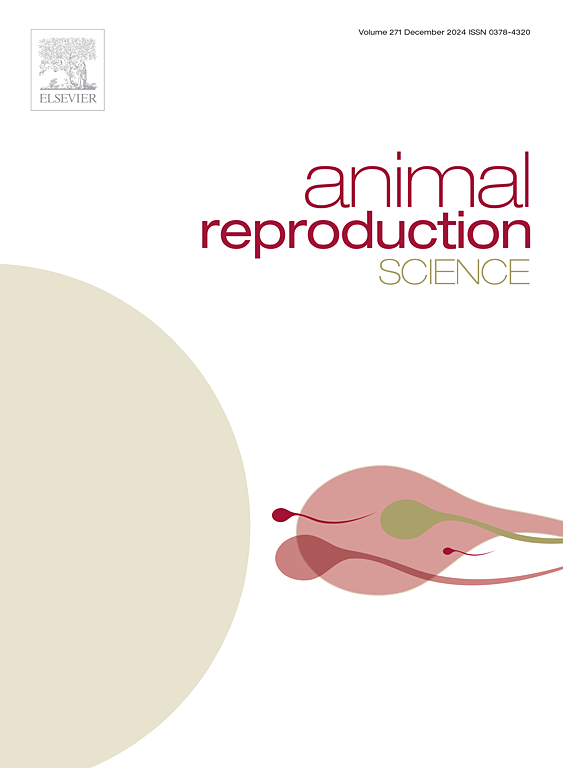Automated color Doppler ultrasound analysis of bull reproductive tissues using a machine learning-based image processing algorithm
IF 3.3
2区 农林科学
Q1 AGRICULTURE, DAIRY & ANIMAL SCIENCE
引用次数: 0
Abstract
Color Doppler ultrasound is effective for studying tissue perfusion of various organs, but current analysis methods are subjective and time-consuming. This study aims to develop and validate an algorithm for analyzing color Doppler images of the bull's testis and pampiniform plexus. For the study, we selected 2304 color Doppler images (1152 for both the testicular parenchyma and the pampiniform plexus) that were analyzed by a conventional method (CON Group), by pixel separation and counting using Adobe Fireworks® and ImageJ®, or by an algorithm developed in Python version 3.10 (ALGO Group) that can be set to analyze up to 35 variables simultaneously. The processing speed for the ALGO Group was 270 images/0.14 sec. The coefficients of determination (R²) for the variables analyzed by the conventional method and the algorithm were found to be considerably high (0.84–0.97, p < 0.001 for testicular parenchyma images; 0.97–0.99, p < 0.001 for pampiniform plexus). The high correlations indicate that the algorithm produces results consistent with the conventional method, demonstrating its reliability. The Pearson correlation coefficients between the conventional analyses and the algorithm were significant (0.92–0.98, p < 0.001 for testicular parenchyma images; 0.98–0.99, p < 0.001 for pampiniform plexus). In addition, Bland-Altman concordance analyses showed that most points fell within the 95 % confidence interval for both techniques in the organs evaluated. Given the strong correlations demonstrated, the reduced processing time, and the reliability of the results, it can be concluded that this algorithmic approach can effectively replace conventional methods for assessing vascular function.
使用基于机器学习的图像处理算法对公牛生殖组织进行自动彩色多普勒超声分析
彩色多普勒超声是研究各器官组织灌注的有效方法,但目前的分析方法主观且耗时。本研究旨在发展并验证一种分析公牛睾丸和大网膜丛彩色多普勒图像的算法。在这项研究中,我们选择了2304张彩色多普勒图像(1152张用于睾丸软组织和旁膝神经丛),这些图像通过传统方法(CON组)、使用Adobe Fireworks®和ImageJ®进行像素分离和计数,或使用Python 3.10版本(ALGO组)开发的算法进行分析,该算法可以设置为同时分析多达35个变量。ALGO组的处理速度为270张/0.14 秒。常规方法和算法分析的变量的决定系数(R²)相当高(睾丸实质图像0.84-0.97,p <; 0.001;pampiniform丛0.97-0.99,p <; 0.001)。高相关性表明该算法得到的结果与传统方法一致,证明了该算法的可靠性。常规分析与算法之间的Pearson相关系数显著(睾丸实质图像0.92-0.98,p <; 0.001;旁膝神经丛0.98-0.99,p <; 0.001)。此外,Bland-Altman一致性分析显示,在评估的器官中,两种技术的大多数点都落在95% %的置信区间内。鉴于所证明的强相关性,减少的处理时间和结果的可靠性,可以得出结论,该算法方法可以有效地取代评估血管功能的传统方法。
本文章由计算机程序翻译,如有差异,请以英文原文为准。
求助全文
约1分钟内获得全文
求助全文
来源期刊

Animal Reproduction Science
农林科学-奶制品与动物科学
CiteScore
4.50
自引率
9.10%
发文量
136
审稿时长
54 days
期刊介绍:
Animal Reproduction Science publishes results from studies relating to reproduction and fertility in animals. This includes both fundamental research and applied studies, including management practices that increase our understanding of the biology and manipulation of reproduction. Manuscripts should go into depth in the mechanisms involved in the research reported, rather than a give a mere description of findings. The focus is on animals that are useful to humans including food- and fibre-producing; companion/recreational; captive; and endangered species including zoo animals, but excluding laboratory animals unless the results of the study provide new information that impacts the basic understanding of the biology or manipulation of reproduction.
The journal''s scope includes the study of reproductive physiology and endocrinology, reproductive cycles, natural and artificial control of reproduction, preservation and use of gametes and embryos, pregnancy and parturition, infertility and sterility, diagnostic and therapeutic techniques.
The Editorial Board of Animal Reproduction Science has decided not to publish papers in which there is an exclusive examination of the in vitro development of oocytes and embryos; however, there will be consideration of papers that include in vitro studies where the source of the oocytes and/or development of the embryos beyond the blastocyst stage is part of the experimental design.
 求助内容:
求助内容: 应助结果提醒方式:
应助结果提醒方式:


